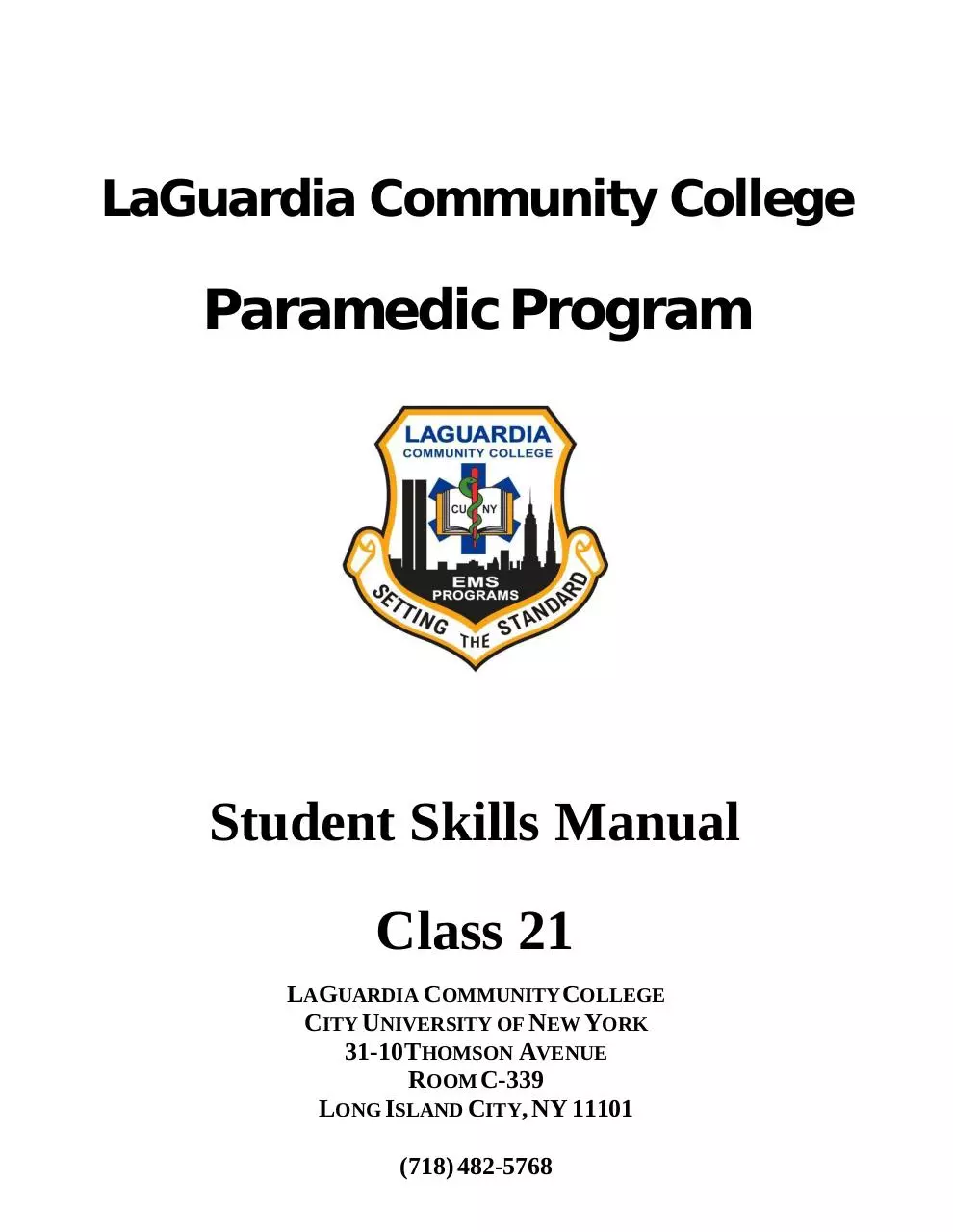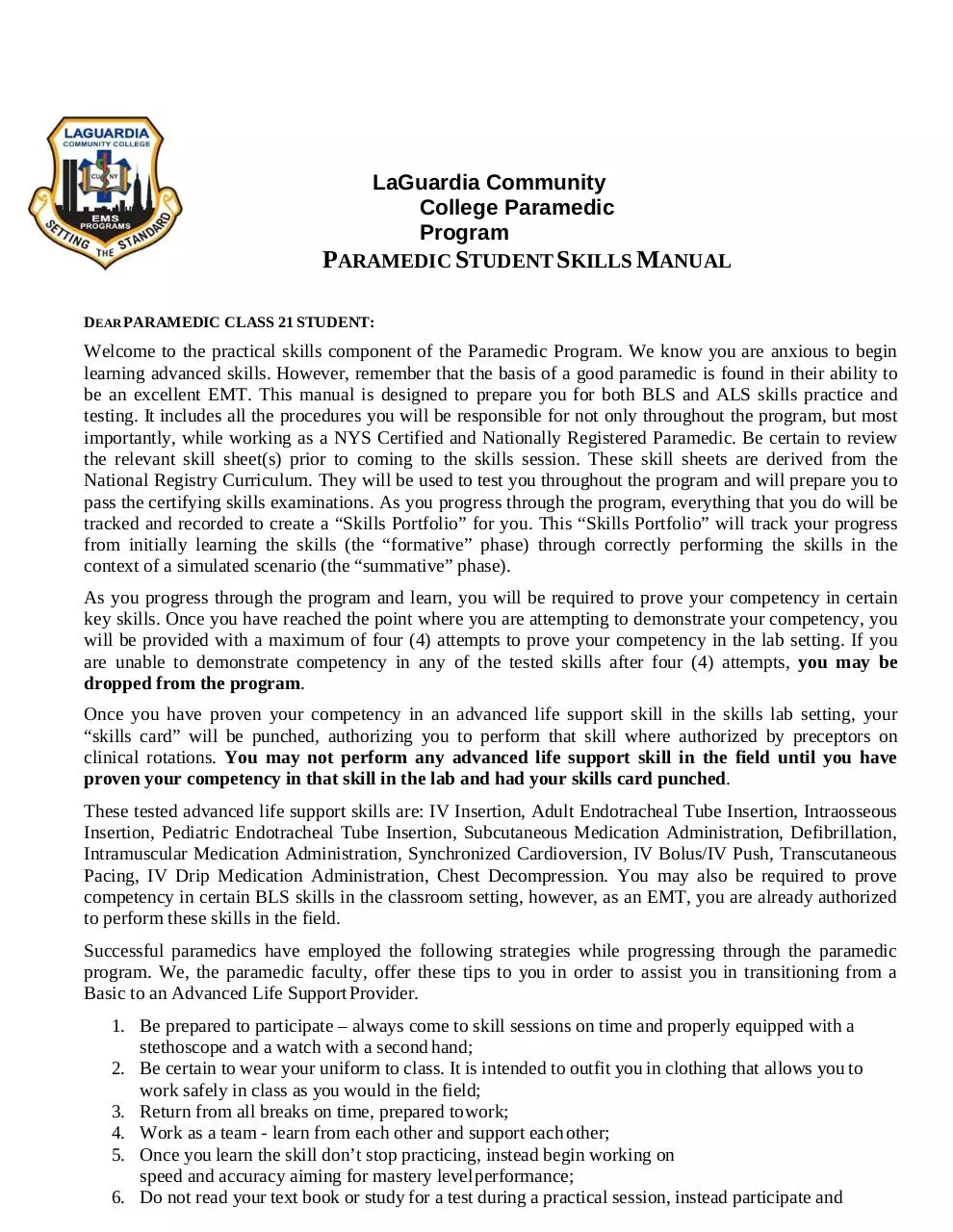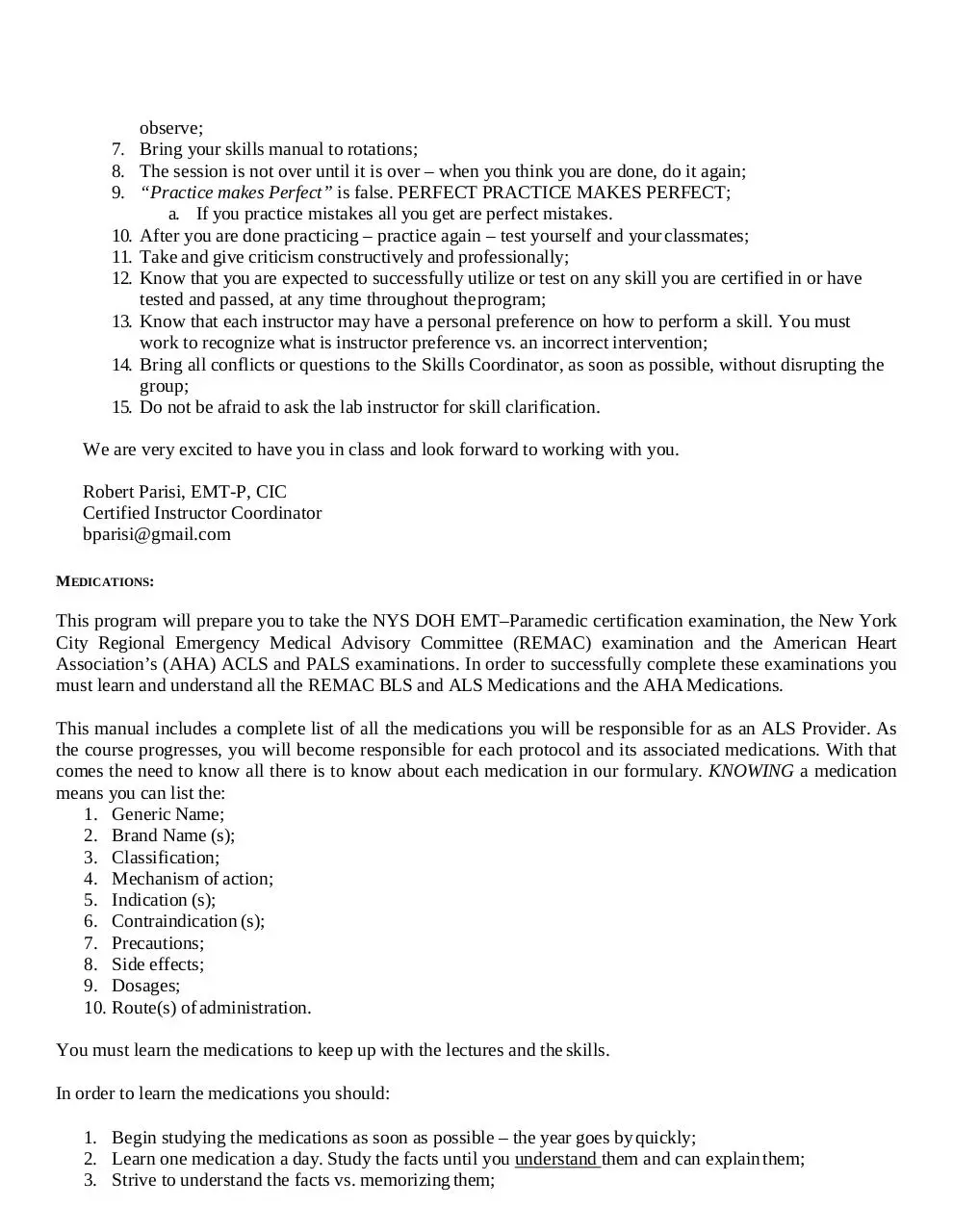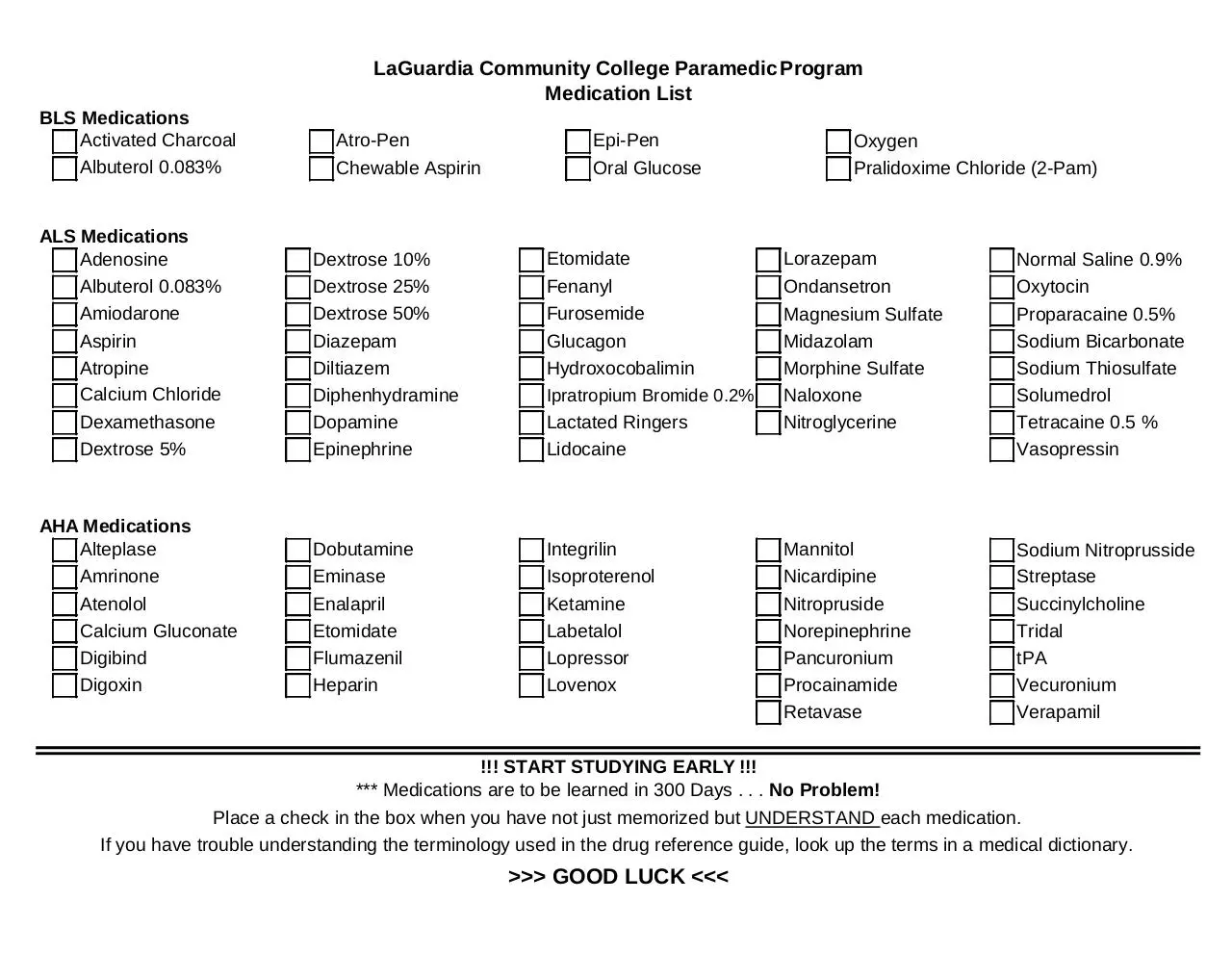Skills Manual Medic 21 (PDF)
File information
Title: Microsoft Word - Medic 21 Skills Manual
Author: matsmith
This PDF 1.5 document has been generated by PScript5.dll Version 5.2.2 / Acrobat Distiller 10.1.13 (Windows), and has been sent on pdf-archive.com on 07/09/2016 at 21:37, from IP address 146.111.x.x.
The current document download page has been viewed 631 times.
File size: 259.84 KB (11 pages).
Privacy: public file





File preview
LaGuardia Community College
Paramedic Program
Student Skills Manual
Class 21
LAGUARDIA COMMUNITY COLLEGE
CITY UNIVERSITY OF NEW YORK
31-10 THOMSON AVENUE
ROOM C-339
LONG ISLAND CITY, NY 11101
(718) 482-5768
LaGuardia Community
College Paramedic
Program
PARAMEDIC STUDENT SKILLS MANUAL
DEAR PARAMEDIC CLASS 21 STUDENT:
Welcome to the practical skills component of the Paramedic Program. We know you are anxious to begin
learning advanced skills. However, remember that the basis of a good paramedic is found in their ability to
be an excellent EMT. This manual is designed to prepare you for both BLS and ALS skills practice and
testing. It includes all the procedures you will be responsible for not only throughout the program, but most
importantly, while working as a NYS Certified and Nationally Registered Paramedic. Be certain to review
the relevant skill sheet(s) prior to coming to the skills session. These skill sheets are derived from the
National Registry Curriculum. They will be used to test you throughout the program and will prepare you to
pass the certifying skills examinations. As you progress through the program, everything that you do will be
tracked and recorded to create a “Skills Portfolio” for you. This “Skills Portfolio” will track your progress
from initially learning the skills (the “formative” phase) through correctly performing the skills in the
context of a simulated scenario (the “summative” phase).
As you progress through the program and learn, you will be required to prove your competency in certain
key skills. Once you have reached the point where you are attempting to demonstrate your competency, you
will be provided with a maximum of four (4) attempts to prove your competency in the lab setting. If you
are unable to demonstrate competency in any of the tested skills after four (4) attempts, you may be
dropped from the program.
Once you have proven your competency in an advanced life support skill in the skills lab setting, your
“skills card” will be punched, authorizing you to perform that skill where authorized by preceptors on
clinical rotations. You may not perform any advanced life support skill in the field until you have
proven your competency in that skill in the lab and had your skills card punched.
These tested advanced life support skills are: IV Insertion, Adult Endotracheal Tube Insertion, Intraosseous
Insertion, Pediatric Endotracheal Tube Insertion, Subcutaneous Medication Administration, Defibrillation,
Intramuscular Medication Administration, Synchronized Cardioversion, IV Bolus/IV Push, Transcutaneous
Pacing, IV Drip Medication Administration, Chest Decompression. You may also be required to prove
competency in certain BLS skills in the classroom setting, however, as an EMT, you are already authorized
to perform these skills in the field.
Successful paramedics have employed the following strategies while progressing through the paramedic
program. We, the paramedic faculty, offer these tips to you in order to assist you in transitioning from a
Basic to an Advanced Life Support Provider.
1. Be prepared to participate – always come to skill sessions on time and properly equipped with a
stethoscope and a watch with a second hand;
2. Be certain to wear your uniform to class. It is intended to outfit you in clothing that allows you to
work safely in class as you would in the field;
3. Return from all breaks on time, prepared to work;
4. Work as a team - learn from each other and support each other;
5. Once you learn the skill don’t stop practicing, instead begin working on
speed and accuracy aiming for mastery level performance;
6. Do not read your text book or study for a test during a practical session, instead participate and
observe;
7. Bring your skills manual to rotations;
8. The session is not over until it is over – when you think you are done, do it again;
9. “Practice makes Perfect” is false. PERFECT PRACTICE MAKES PERFECT;
a. If you practice mistakes all you get are perfect mistakes.
10. After you are done practicing – practice again – test yourself and your classmates;
11. Take and give criticism constructively and professionally;
12. Know that you are expected to successfully utilize or test on any skill you are certified in or have
tested and passed, at any time throughout the program;
13. Know that each instructor may have a personal preference on how to perform a skill. You must
work to recognize what is instructor preference vs. an incorrect intervention;
14. Bring all conflicts or questions to the Skills Coordinator, as soon as possible, without disrupting the
group;
15. Do not be afraid to ask the lab instructor for skill clarification.
We are very excited to have you in class and look forward to working with you.
Robert Parisi, EMT-P, CIC
Certified Instructor Coordinator
bparisi@gmail.com
MEDICATIONS:
This program will prepare you to take the NYS DOH EMT–Paramedic certification examination, the New York
City Regional Emergency Medical Advisory Committee (REMAC) examination and the American Heart
Association’s (AHA) ACLS and PALS examinations. In order to successfully complete these examinations you
must learn and understand all the REMAC BLS and ALS Medications and the AHA Medications.
This manual includes a complete list of all the medications you will be responsible for as an ALS Provider. As
the course progresses, you will become responsible for each protocol and its associated medications. With that
comes the need to know all there is to know about each medication in our formulary. KNOWING a medication
means you can list the:
1. Generic Name;
2. Brand Name (s);
3. Classification;
4. Mechanism of action;
5. Indication (s);
6. Contraindication (s);
7. Precautions;
8. Side effects;
9. Dosages;
10. Route(s) of administration.
You must learn the medications to keep up with the lectures and the skills.
In order to learn the medications you should:
1. Begin studying the medications as soon as possible – the year goes by quickly;
2. Learn one medication a day. Study the facts until you understand them and can explain them;
3. Strive to understand the facts vs. memorizing them;
4. Use family members, friends, classmates or partners to assist you in learning the medications;
5. Read the material into a recorder then listen to it as you drive to work or as you go to sleep – Passive
Learning Works;
6. Create and study flash cards, which list all the drug facts for a given medication;
7. Study and relate each medication to how a patient presents when the medication is indicated.
8. Study the medications in tandem with the protocols. The protocols are easier to learn if you understand
how the medication works and the rationale for it being in the protocol.
BLS Medications
Activated Charcoal
Albuterol 0.083%
LaGuardia Community College Paramedic Program
Medication List
Atro-Pen
Chewable Aspirin
ALS Medications
Adenosine
Albuterol 0.083%
Amiodarone
Aspirin
Atropine
Calcium Chloride
Dexamethasone
Dextrose 5%
Epi-Pen
Oral Glucose
Dobutamine
Eminase
Enalapril
Etomidate
Flumazenil
Heparin
Oxygen
Pralidoxime Chloride (2-Pam)
Etomidate
Fenanyl
Furosemide
Glucagon
Hydroxocobalimin
Ipratropium Bromide 0.2%
Lactated Ringers
Lidocaine
Dextrose 10%
Dextrose 25%
Dextrose 50%
Diazepam
Diltiazem
Diphenhydramine
Dopamine
Epinephrine
AHA Medications
Alteplase
Amrinone
Atenolol
Calcium Gluconate
Digibind
Digoxin
Lorazepam
Ondansetron
Normal Saline 0.9%
Oxytocin
Proparacaine 0.5%
Sodium Bicarbonate
Sodium Thiosulfate
Solumedrol
Tetracaine 0.5 %
Vasopressin
Magnesium Sulfate
Midazolam
Morphine Sulfate
Naloxone
Nitroglycerine
Integrilin
Isoproterenol
Ketamine
Labetalol
Lopressor
Lovenox
Mannitol
Nicardipine
Nitropruside
Norepinephrine
Pancuronium
Procainamide
Retavase
Sodium Nitroprusside
Streptase
Succinylcholine
Tridal
tPA
Vecuronium
Verapamil
!!! START STUDYING EARLY !!!
*** Medications are to be learned in 300 Days . . . No Problem!
Place a check in the box when you have not just memorized but UNDERSTAND each medication.
If you have trouble understanding the terminology used in the drug reference guide, look up the terms in a medical dictionary.
>>> GOOD LUCK <<<
Introduction To Medication Calculations
Volume
Weight
mcg. = microgram
mg. = milligram
1 mg = 1,000 mcg
ml = milliliter
G. = gram
1 G. = 1,000 mg
Kg. = kilogram
1 Kg = 1,000 G
lb. = Pound
2.2 lb = 1 Kg
# of lb / 2.2 = # of Kg
gr. = grain 1 gr. = 60 mg.
Example 1/150 gr. = 0.4 mg
2 gr. = 120 mg
L = Liter
1 L = 1,000 ml
IV administration sets
Mini drip 60 gtts = 1 ml
Macro drip 10 gtts = 1ml
(some manufactures 15 gtts =
1ml) 1 teaspoon = 5 ml
1 tablespoon = 15 ml = 3 teaspoon
Dose = the weight of a drug administered to a pt.
Example: 1 mg of Epinephrine
Concentration = the weight of a drug in a given volume Example: 1mg per ml
1mg per 2ml = 0.5 mg per ml
Additional Abbreviations
DD = Desired Dose
DOH = Dose on Hand
V = Volume
T = Time
gtt = drop
cc = cubic centimeter
Rights of Medication Administration
Right Dose
Right Drug
Right Time
Right Patient
Right Route
Right Documentation
= Concentration
(1 ml takes up 1 cc of space)
Solution Concentrations
Percent (%) Solution = the # of G. in 100 ml Example:
50% solution = 50 G in 100 ml
Example:
Proportional solutions = the # of G. in? ml.
1:1000 = 1 G in 1,000 ml
1:10000 = 1 G in 10,000 ml
Math Review
0.4
+ 0.5
0.9
0.4
+ 0.05
0.45
½ + ½ = 2/2 = 1
½ -½ = 0
1.2
+ 1.9
3.1
0.8
- 0.4
0.4
½ x ½ =¼
0.8
2.7
- 0.04
-1.5
0.76
1.2
2.07
- 0.4
1.67
½ / ½ = ½ x 2/1 = 2/2 = 1
Do not divide fractions, invert the 2nd value & multiply
Reduce
1 : 1000 Solution
=
1G : 1000 ml
= 1000 mg : 1000 ml
=
1 mg : 1 ml
50 % Solution
50 G / 100 ml
1 G / 2 ml
1000 mg / 2 ml
500 mg / ml or 0.5 G / ml
=
=
=
=
1 G / 250 ml
= 1000 mg / 250 ml
=
4 mg / 1 ml
=
=
400 mg / 250 ml
400,000 mcg / 250 ml
1,600 mcg / ml
Remember – whatever you do to one side of the equation, you must do to the other side
1
Mega Code
Oral Scenarios Type
Math Review
Physical Skills Type
Student's Name
K
PS TW
A
Mx Class 21
Instructor
Today's Date
Skill Stat
Paramedic Skills Station Evaluation Record
Sign
Comments
Total
2
3
4
5
6
1
2
3
4
5
6
1
2
3
4
5
6
0 = Student was present but did not participate. Left session early (enter reason in comments)
1 = Introductory Level - Needs guidance, monitoring and instruction to complete the skill
2 = Satisfactory - Minor Errors or Omissions.
3 = Good No Omissions, proficient with minimal prompting orguidance.
4 = Excellent Complete Skill without error, omission or prompting. Meets DOH Guidelines.
Total Score <8 = Below par
K = Knowledge
P = Problem Solving
A = Application
T=Teamwork
CIC Review Signature
Director Review Signature
back
Paramedic Skills Station - Student Evaluation Record
Date
Instructor
Mx Class
21
Print and Sign
Comments
Student's Name
Non-Student Station Challenges, Difficulties or Problems
Missing / Needed Supplies or Equipment
Student Skills Station Signature Sheet
Skill Station Name
Date
DAY
Print Name
Initial
Sat.
N.I.
Instructor
EVENING
Comments
Sat. = Satisfactory
Bring special comments to the attention
N.I. = Needs Improvement
of the CIC and/or Skills Coordinator
Continue on Back of Page
MEDIC
Download Skills Manual Medic 21
Skills Manual Medic 21.pdf (PDF, 259.84 KB)
Download PDF
Share this file on social networks
Link to this page
Permanent link
Use the permanent link to the download page to share your document on Facebook, Twitter, LinkedIn, or directly with a contact by e-Mail, Messenger, Whatsapp, Line..
Short link
Use the short link to share your document on Twitter or by text message (SMS)
HTML Code
Copy the following HTML code to share your document on a Website or Blog
QR Code to this page

This file has been shared publicly by a user of PDF Archive.
Document ID: 0000481102.